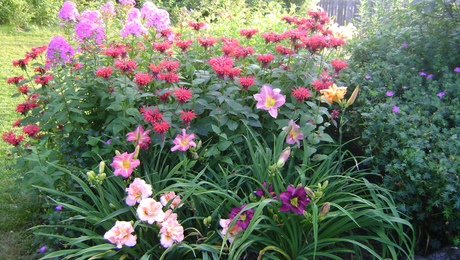
We’re visiting Lilli Hazard’s garden in Fishers, Indiana, today.
I love gardening and caught the disease that gave me my green thumb from my mother when I was about 10 years old. She and I would pore through catalogs picking out those special flowers that would be added to our landscape. Now I do the same on my own.
Through the years I’ve become very interested in native plants, and I try to add them to my suburban gardens wherever I can.
I love variety. Here is a sampling of what I have. Most are perennials.
 The airy plumes of Astilbe (Zones 4–8) flowers. These perennials do well in shade and prefer soil that doesn’t dry out. If you have the right spot for them, they can be one of the showiest shade perennials out there.
The airy plumes of Astilbe (Zones 4–8) flowers. These perennials do well in shade and prefer soil that doesn’t dry out. If you have the right spot for them, they can be one of the showiest shade perennials out there.
 A cream—almost white—daylily (Hemerocallis hybrid, Zone 4—9) bloom. Daylilies come in nearly every color of the rainbow, but none of them are quite true white.
A cream—almost white—daylily (Hemerocallis hybrid, Zone 4—9) bloom. Daylilies come in nearly every color of the rainbow, but none of them are quite true white.
 Another daylily, this one in a pink shade.
Another daylily, this one in a pink shade.





Have a garden you’d like to share?
Have photos to share? We’d love to see your garden, a particular collection of plants you love, or a wonderful garden you had the chance to visit!
To submit, send 5-10 photos to gpod@taunton.com along with some information about the plants in the pictures and where you took the photos. We’d love to hear where you are located, how long you’ve been gardening, successes you are proud of, failures you learned from, hopes for the future, favorite plants, or funny stories from your garden.
If you want to send photos in separate emails to the GPOD email box that is just fine.
Have a mobile phone? Tag your photos on Facebook, Instagram or Twitter with #FineGardening!
You don’t have to be a professional garden photographer – check out our garden photography tips!
Do you receive the GPOD by email yet? Sign up here.
Fine Gardening Recommended Products

The Nature of Oaks: The Rich Ecology of Our Most Essential Native Trees
Fine Gardening receives a commission for items purchased through links on this site, including Amazon Associates and other affiliate advertising programs.

Pruning Simplified: A Step-by-Step Guide to 50 Popular Trees and Shrubs
Fine Gardening receives a commission for items purchased through links on this site, including Amazon Associates and other affiliate advertising programs.

Planting in a Post-Wild World: Designing Plant Communities for Resilient Landscapes
Fine Gardening receives a commission for items purchased through links on this site, including Amazon Associates and other affiliate advertising programs.


















Comments
Beautiful! And love the combo of your zinnias and the hibiscus!
Your Astilbe are just fabulous and full and deep in color- I'v never seen any as pretty as those. I've learned from you that they need soil that doesn't dry out...thanks for sharing that information.
Your Rose is so healthy looking too, and I'm happy to learn it's name and that it's fragrant.
I'm still waiting for my Tree Peony to bloom, only had it for a year now, yours is doing great!
I also really like your very low cement water feature with the pebbles in the water next to the Astilbe...so serene.
You have a wide variety of healthy colorful plants. Your green thumb has given you success with astilbe that I long for, and your tree peony looks very happy. Please send more pictures, perhaps of more of your natives, or of 'long shots' showing us more of how your garden is laid out. We look forward to that!
Log in or create an account to post a comment.
Sign up Log in